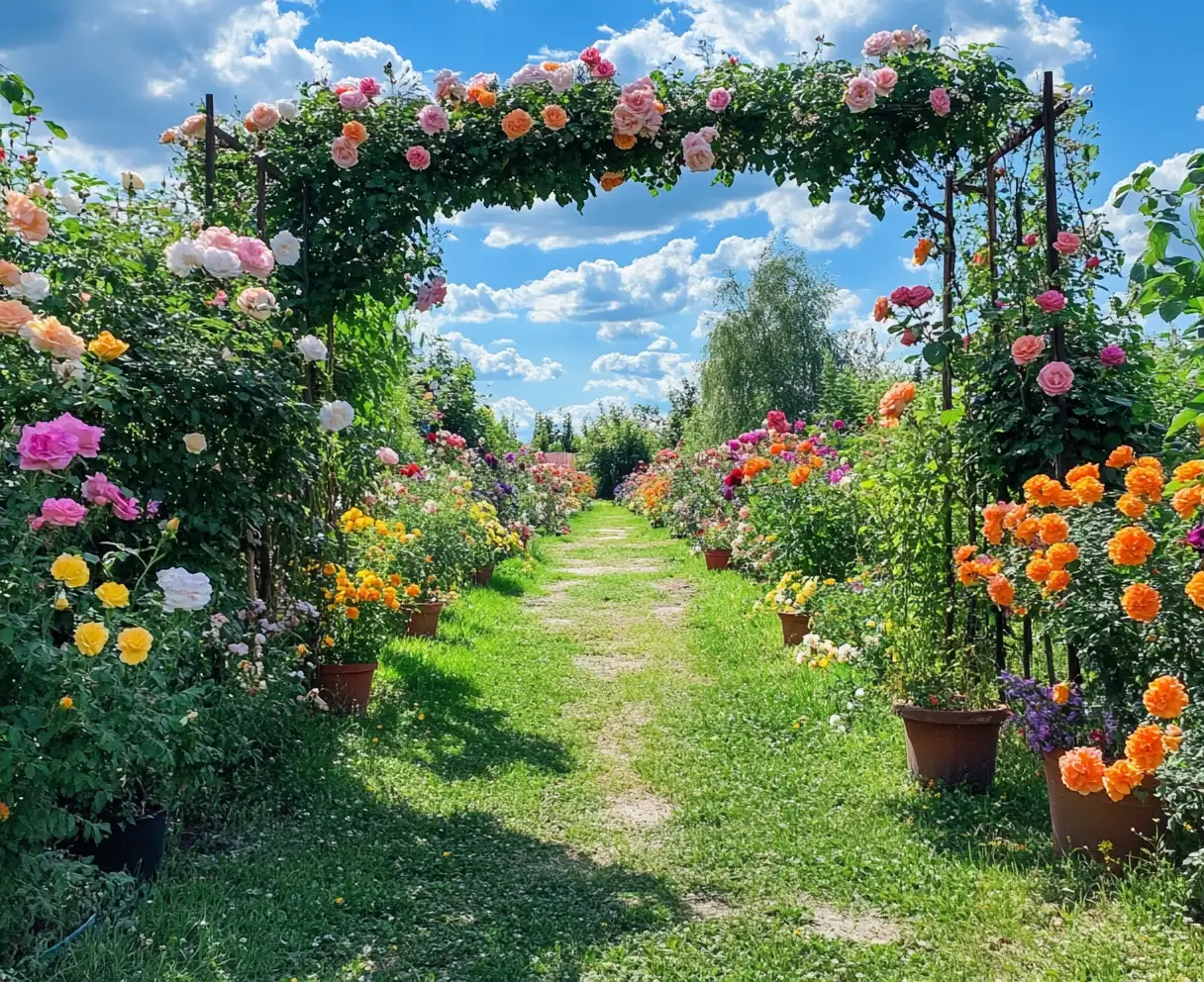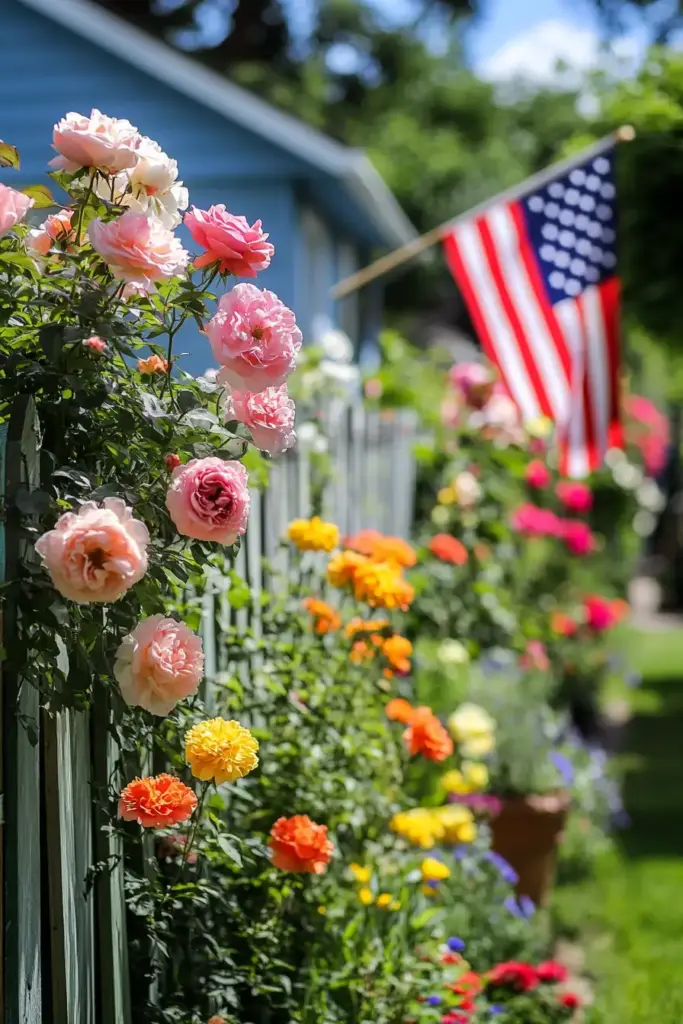Trellis for climbing roses doesn’t have to be complicated, expensive, or time-consuming. If you’re looking for a fast, budget-friendly way to support your beautiful climbers, this bamboo DIY method is your perfect weekend project—done in under five minutes! Whether you’re just starting your rose garden or need a quick solution while planning a more permanent rose trellis, this approach will get your canes climbing skyward with ease.
Let’s explore how to build a simple, sturdy trellis that promotes healthy growth and transforms your yard. And if you’re dreaming bigger, check out these 7 gorgeous ways to display climbing roses for even more garden inspiration—without breaking the bank.
🌿 Love gardening inspiration? Follow me on Pinterest for bold plant ideas, tips, and seasonal color!
Table of Contents
🌱 Why Climbing Roses Need a Trellis
Using a trellis for climbing roses isn’t just about aesthetics—though a cascading wall of rose blooms is certainly a showstopper. A well-structured support system plays a critical role in the plant’s health, productivity, and shape.
🌼 Key Benefits of Using a Trellis for Climbing Roses
- More Blooms, Less Chaos: Climbing roses naturally want to sprawl. By giving them vertical guidance, you encourage organized growth and more frequent flowering.
- Easier Maintenance: Pruning, deadheading, and inspecting your roses becomes simpler when the canes are lifted off the ground.
- Enhanced Air Circulation: Keeping the plant upright reduces the risk of fungal diseases, especially around the base where moisture can collect.
- Customizable Aesthetics: Whether you want a romantic arch, a neat fan shape, or a cottage-style sprawl, a trellis gives you control over how your rose grows.
🌿 The Science Behind Trellising
Climbing roses produce the majority of their flowers on lateral canes—those horizontal or diagonally bent stems that shoot off from the main cane. By training the main cane at a 45° angle, you signal the plant to push out more of these flowering branches. It’s a clever, natural way to boost your rose’s bloom potential without synthetic fertilizers.
🪴 Common Trellis Options for Roses
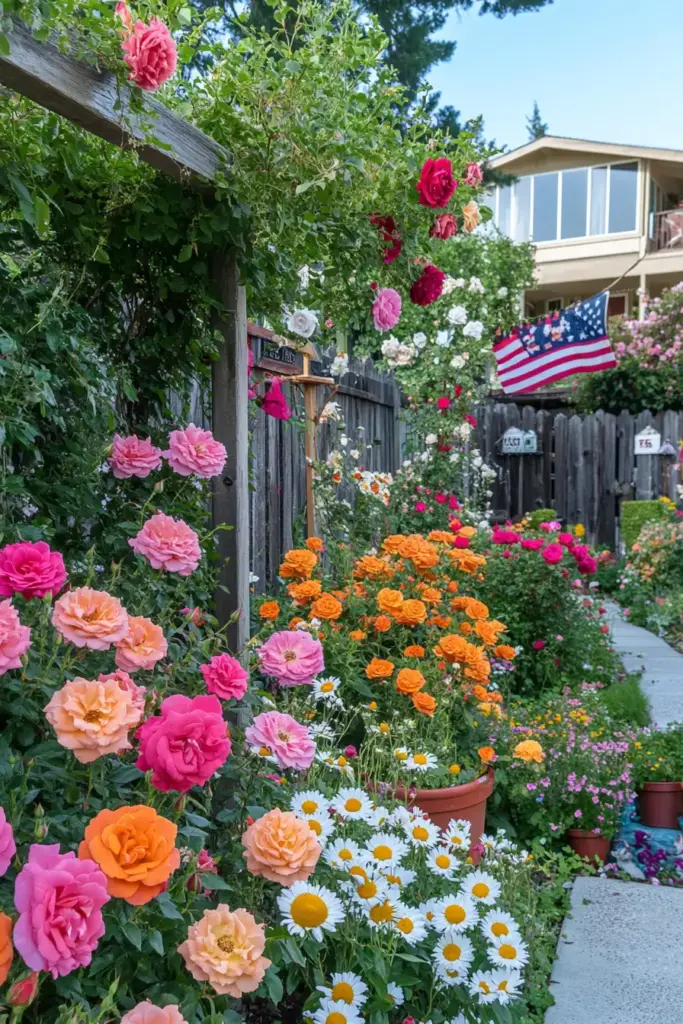
When choosing the best trellis for climbing roses, there’s no shortage of options. From decorative arches to minimalist bamboo setups, the right choice depends on your space, budget, and long-term goals. Here’s a breakdown of the most popular types, including pros and cons to help you decide.
🌳 Traditional Wood or Metal Trellises
- Pros: Sturdy, visually striking, and long-lasting.
- Cons: Often pricey, heavy, and may require professional installation.
🌿 Arches and Gazebos
- Pros: Create dramatic entrances or focal points; ideal for large gardens.
- Cons: Require more space and time to assemble; not always beginner-friendly.
🧱 Lattice Panels
- Pros: Perfect for attaching to walls and fences; supports wide coverage.
- Cons: May need additional anchors or framing for strength.
🍅 Tomato Cages
- Pros: A clever, compact option for smaller climbing roses or container gardens.
- Cons: Limited height and support—best for temporary use.
🎍 Bamboo Sticks (Our Focus)
- Pros: Inexpensive, biodegradable, and great for early training.
- Cons: Not permanent, but practical for 1–3 seasons.
Among all these, bamboo sticks stand out as the easiest and most budget-conscious solution for beginner gardeners—especially if you’re nurturing young climbers and want something quick, effective, and gentle.
🎍 Why Bamboo Sticks Are Great

If you’re looking for a low-cost, easy-to-install trellis for climbing roses, bamboo sticks are hard to beat. They offer just the right balance between function and flexibility, especially for gardeners who are short on time, tools, or funds.
🌟 Benefits of Using Bamboo as a Trellis
- Lightweight & Easy to Work With: No heavy lifting or special tools needed.
- Biodegradable & Eco-Friendly: Bamboo naturally breaks down over time, making it a sustainable choice for temporary support.
- Budget-Friendly: Often available at dollar stores or garden centers for just a few bucks.
- Blends Naturally into the Garden: The organic look of bamboo pairs beautifully with roses, unlike bright plastic or shiny metal.
- Perfect for Young Climbing Roses: Ideal for the first 1–3 years while your rose develops strength and structure.
While bamboo won’t last forever, it doesn’t need to. This setup gives your roses a strong, structured start—while you plan and budget for a more permanent feature down the line.
🧰 Materials List for DIY Bamboo Trellis
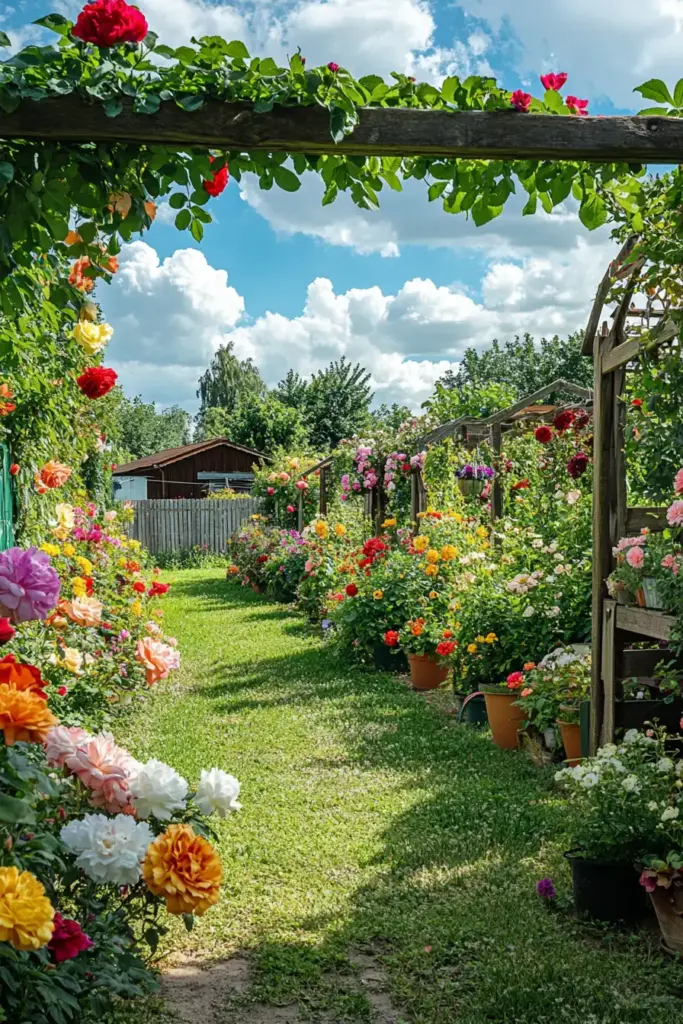
Building a quick and sturdy trellis for climbing roses doesn’t require power tools or a trip to the hardware store. In fact, most of what you need is probably already in your garden shed—or can be picked up affordably at any gardening supply shop.
🛒 What You’ll Need
- 2 to 3 Bamboo Sticks (each 4–5 feet tall)
→ Choose sticks tall enough to guide the main canes upward with room to grow. - Garden Twine or Jute String
→ Avoid wire or synthetic cord that might cut into the stems. - Garden Shears or Scissors
→ For trimming twine and snipping any stray canes.
🧤 Optional Items (for Comfort & Stability)
- Gloves: Protect your hands from thorns.
- Mallet or Hammer: Useful if your soil is tough and you need to tap in the bamboo sticks firmly.
This minimalist materials list means anyone—whether you’re a first-time gardener or a seasoned pro—can have a trellis in place with minimal prep and zero stress.
🛠️ Step-by-Step Instructions
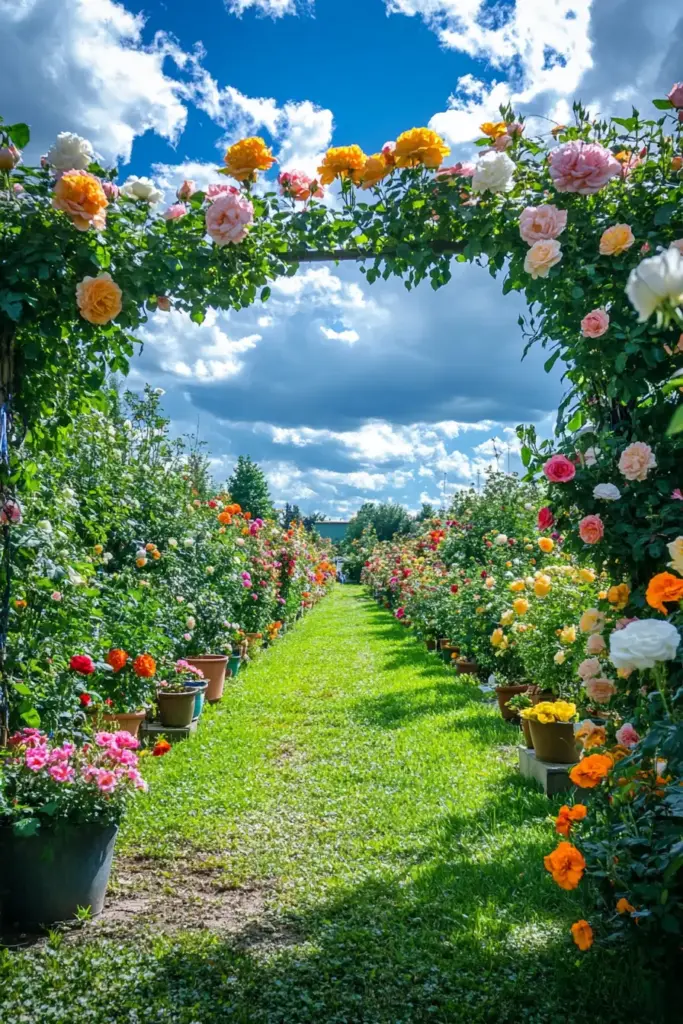
Now comes the fun part—building your very own trellis for climbing roses in just a few minutes! This method is beginner-friendly, safe for your plants, and requires no special skills. Just follow these steps, and your roses will be climbing in no time.
1. Place the Bamboo Sticks
- Insert 2–3 bamboo poles into the soil around the base of your rose bush.
- Arrange them in a teepee or triangle shape to provide all-around support.
- Push each stick at least 4–6 inches deep into the ground for stability.
2. Tie the Tops Together
- Gather the tops of the bamboo sticks and tie them securely using your twine.
- Wrap the twine multiple times to ensure strength, then knot tightly.
- This forms a sturdy central point where all canes can be trained toward.
3. Train the Rose Canes
- Gently bend your main canes to a 45° angle. This encourages lateral shoots—the source of those beautiful blooms.
- Use twine to loosely tie each cane to a bamboo stick. Never tie too tightly; the plant needs room to grow.
- If a cane doesn’t reach, use a longer length of twine to guide and support it.
💡 Pro Tip: Some canes may be flexible enough to gently weave around the structure. Others might be stiffer—if so, take your time and never force the bend. A broken cane won’t bloom.
This lightweight trellis will start shaping your rose from day one—and it only takes about 5 minutes to build!
💡 Maintenance Tips
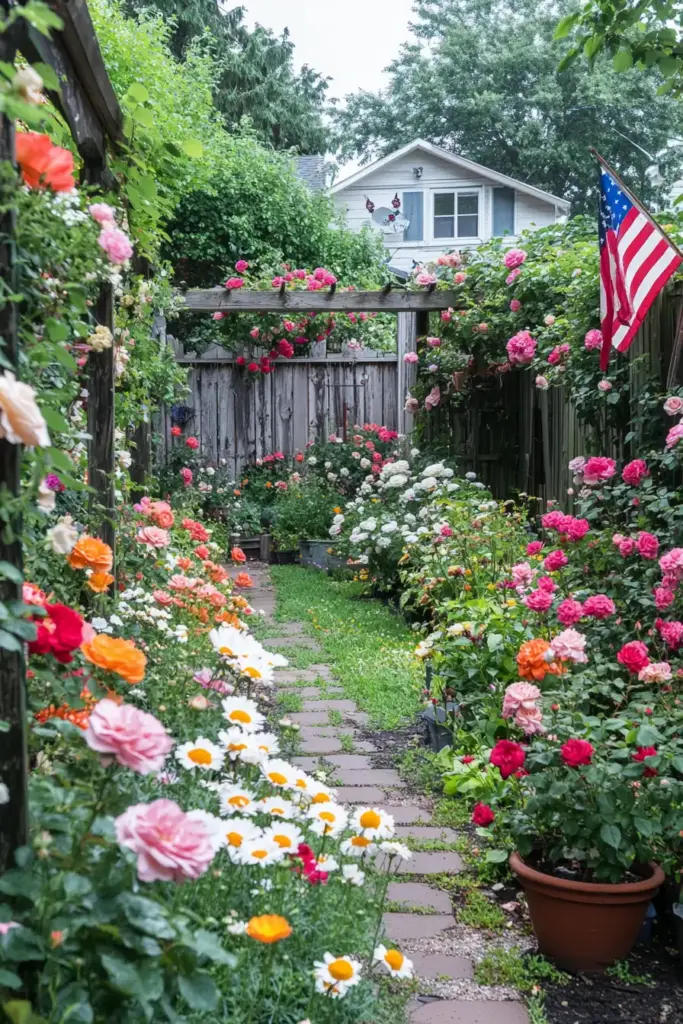
Once your DIY trellis for climbing roses is in place, a little ongoing care will keep your plant healthy, vibrant, and beautifully shaped. Here’s how to get the most out of your bamboo setup—season after season.
🔁 1. Check and Adjust Ties Regularly
- As your rose grows, revisit the twine ties to make sure they’re not too tight.
- Loosen them as needed to avoid cutting into the stems or restricting growth.
✂️ 2. Prune with Purpose
- In late winter or early spring, remove:
- Dead or diseased canes
- Canes that stray from your intended shape
- Spent blooms, which encourages new flowers
- New canes? Train them early to maintain your trellis shape.
🌬️ 3. Reinforce as Needed
- Bamboo is strong but not invincible—especially in high winds or heavy rain.
- Check for wobbles or weather damage, and add fresh twine or swap in new sticks when necessary.
🌸 4. Encourage Lateral Growth
- Always train long canes at a 45° angle to spark the formation of lateral shoots—the branches where blooms appear.
- The more laterals, the more roses!
🗓️ Seasonal Tip: Bamboo trellises typically last 1 to 3 years, making them perfect for beginner gardeners or temporary use while waiting on a more permanent structure.
🧾 Conclusion
Creating a quick and affordable trellis for climbing roses doesn’t require fancy materials or a green thumb. With just a few bamboo sticks and some twine, you can give your roses the essential support they need—encouraging healthier growth, more blooms, and a stunning vertical display. For a full walkthrough, don’t miss our DIY bamboo rose trellis guide.
This DIY solution is ideal for beginners, renters, or anyone waiting to upgrade to a more permanent rose support. It’s a low-cost, low-effort method that pays off with a garden full of thriving roses trained to grow tall, bloom wide, and impress throughout the season.
Give your roses the structure they need—and while you’re at it, check out our top climbing rose varieties to elevate your garden game even further.
1. Can I use bamboo stakes for mature climbing roses?
Yes—but with caution. Bamboo stakes are best for young or newly planted roses. For larger, established climbers with heavier canes, a sturdier and more permanent trellis (like wood or metal) is recommended.
2. How tall should a trellis be for climbing roses?
Most climbing roses grow 6 to 12 feet tall, so your trellis should be at least 5–6 feet to accommodate vertical growth. Bamboo sticks can provide temporary support during the first few feet of development.
3. When is the best time to install a trellis?
Early spring or late winter is ideal. This is when you’re doing your major pruning and before new growth takes off. Installing the trellis at this time minimizes damage to canes and makes training easier.
4. How do I tie rose canes without damaging them?
Use soft garden twine, jute, or cloth strips. Avoid wire or string that can cut into the stems. Tie loosely in a figure-eight pattern so the cane has room to grow and sway slightly in the wind.
5. Do climbing roses need pruning every year?
Yes. Prune annually to:
Remove dead or diseased wood
Encourage lateral growth (for more blooms)
Shape the rose and control size
Regular pruning also helps maintain airflow and reduces disease risk.
6. How long will a bamboo trellis last?
Typically 1–3 years, depending on climate and weather exposure. It’s a great short-term option that can be easily replaced or upgraded later.
7. Can I reuse bamboo sticks?
If they’re still sturdy and free of rot or cracks, absolutely. Just sanitize them with a diluted vinegar or bleach solution before reuse to prevent disease transfer between plants.

